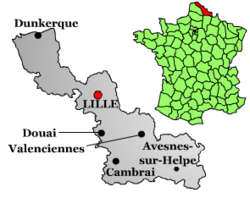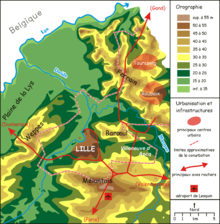Lille
![]()
The title of this article is ambiguous. For other meanings, see Lille (disambiguation).
Template:Infobox commune in France/maintenance/alternate coat of arms in Wikidata
Lille ([lil] ![]() , Dutch Rijsel [rɛɪsəl],) is a large city in northern France on the border with Belgium. Lille is prefecture of the Nord department and capital of the Hauts-de-France region. It is nicknamed the "Capital of Flanders" and, with 233,098 inhabitants (as of 1 January 2018), is a core city of the Métropole Européenne de Lille, a federation of 85 municipalities with a population of 1.1 million, along with Roubaix, Tourcoing and Villeneuve-d'Ascq.
, Dutch Rijsel [rɛɪsəl],) is a large city in northern France on the border with Belgium. Lille is prefecture of the Nord department and capital of the Hauts-de-France region. It is nicknamed the "Capital of Flanders" and, with 233,098 inhabitants (as of 1 January 2018), is a core city of the Métropole Européenne de Lille, a federation of 85 municipalities with a population of 1.1 million, along with Roubaix, Tourcoing and Villeneuve-d'Ascq.
As the largest city, Lille, together with neighbouring cities in Belgium (Mouscron, Kortrijk, Tournai and Menen), forms a large conurbation and, from January 2008, the first European Grouping for Territorial Cooperation, in the Lille-Kortrijk-Tournai Eurodistrict, with a total population of two million. Together with the cities of the former mining district of Nord-Pas-de-Calais, it also forms part of the Lille metropolitan region, which has a population of 3.5 million.
Geography
Location
LIlle is located in the north of France, in the centre of the Nord department and on the border with Belgium, twenty kilometres from the Flanders region to the north and Wallonia to the east.
Lille lies at the junction of many major European trunk roads (see below) and several railway lines running east-west between Germany, Luxembourg, Belgium and the United Kingdom, and north-south between the Netherlands, Belgium, France and Spain.
The nearest major city is Roubaix, about 10 km to the northeast. The distance to the port city of Dunkirk on the North Sea is 80 km. The European capitals of Brussels, Paris and London are 110 km, 205 km and 242 km away respectively.
Before the end of the Western Roman Empire, Germanic tribes settled north of the Boulogne-sur-Mer - Cologne line in the middle of the fourth century, which led to the shift of the language border south of Lille. As a result, many place names were formed with the toponym hem, such as Wazemmes, Vauban Esquermes or Hellemmes (=Lille). Nevertheless, unlike Dunkirk or Bailleul, Lille and its surroundings belonged to the historical region of Romanesque Flanders, which, as a former territory of the County of Flanders, did not belong to the West Flemish language area. During the founding of the city of Lille in the eleventh century, the language border shifted to the west of the city. Consequently, contrary to popular belief, Lille was never a Flemish-speaking city, but always a Romance city.
Topography and geology
The city of Lille is located at an altitude of about 20 m in a bulge of the Deûle valley. At this point, the last Senonian and Turonian Cretaceous outcrops of the Mélantois natural area submerge beneath the hilly landscapes of the Weppes to the west and the Barœul to the north, formed in the Landenian sand and Ypresian clay. The young sedimentary cover of the Pleistocene is everywhere - either in the form of loess on slopes or as alluvial soil in the valley bottoms.
Today, most of the arms of the Deûle run underground through the city. The river, which has been navigated since the Gallo-Roman era, flows through the city in the southwest and flows further north into the Leie (French: Lys), which has also been canalized there and which in turn flows into the Scheldt.
Neighboring communities
Lille forms the centre of the Métropole Européenne de Lille, which also includes all neighbouring municipalities. Except for the largely rural municipalities of Ennetières-en-Weppes, Capinghem, Prémesques, Pérenchies and Lompret in the west, all other surrounding municipalities lie within the contiguous settlement area of the city. The largest of these are Villeneuve-d'Ascq in the east with 63,000 inhabitants and Marcq-en-Barœul in the northeast with 39,000 inhabitants. Other larger municipalities with over 10,000 inhabitants are concentrated in the north (Lambersart, La Madeleine, Saint-André-lez-Lille, Mons-en-Barœul) and in the south (Loos-lez-Lille, Wattignies, Faches-Thumesnil, Ronchin).
Climate
| Lille | ||||||||||||||||||||||||||||||||||||||||||||||||
| Climate diagram | ||||||||||||||||||||||||||||||||||||||||||||||||
| ||||||||||||||||||||||||||||||||||||||||||||||||
| Monthly average temperatures and precipitation for Lille
Source: Météo-France; humidity, sunshine hours: wetterkontor.de | ||||||||||||||||||||||||||||||||||||||||||||||||||||||||||||||||||||||||||||||||||||||||||||||||||||||||||||||||||||||||||||||||||||||||||||||||||||||||||||||||||||||||||||||||||||||||||||||||||||||||||||||||||||||||||||||||||||||||||||||||||||||||||||

the canalized river Deûle. It flows around the citadel of Lille

Location of the city of Lille within France and the department of Nord

Topography of the city of Lille
Population
The city of Lille, including the communes of Lomme and Hellemmes, which have been incorporated into the city in recent years, has a population of 233,098 (as of 1 January 2018). More than 1.1 million (1999) inhabitants live in the metropolitan area around Lille, which includes its neighbouring towns of Roubaix and Tourcoing and the satellite town of Villeneuve-d'Ascq, founded in 1970. This metropolitan area, the Métropole Européenne de Lille, is the fourth largest metropolitan area in terms of population after Paris, Lyon and Marseille, and is second in France in terms of population density.
Lille is the city with the highest proportion of students, between 90,000 and 110,000 at the Université Lille Nord de France, depending on how you count.
| Year | 1962 | 1968 | 1975 | 1982 | 1990 | 1999 | 2007 | 2017 |
| Inhabitants | 193.096 | 190.546 | 172.280 | 168.424 | 172.142 | 212.566 | 225.789 | 232.787 |
Questions and Answers
Q: Where is Lille located?
A: Lille is located in the north of France.
Q: What is the population of Lille?
A: The population of Lille is about 226,800 inhabitants.
Q: What is the capital of the region in which Lille is located?
A: Lille is the capital of the region Hauts-de-France.
Q: How is Lille known in Dutch?
A: In Dutch, Lille is called Rijsel.
Q: What is the urban area shared with Lille?
A: The urban area shared with Lille is Kortrijk and Tournai.
Q: How many people live in the urban area shared with Kortrijk and Tournai?
A: Approximately two million people live in the urban area shared with Kortrijk and Tournai.
Q: What is the rank of the urban area shared with Kortrijk and Tournai in France?
A: The urban area shared with Kortrijk and Tournai is the fifth largest in France, behind Paris, Lyon, Marseille, and Toulouse.
Search within the encyclopedia